 Pop Culture
Pop Culture  Pop Culture
Pop Culture  Our World
Our World 10 Ordinary Things Likely Disappearing from Our Lives Soon
 Humans
Humans 10 Incredible Tunnel Escapes
 Travel
Travel 10 Surprising Ways Modern Visitors Have Harmed Historic Sites
 Food
Food 10 Dark Stories About Bananas
 Technology
Technology 10 New Jobs Emerging from Real-World Trends
 Movies and TV
Movies and TV 10 Happy Endings Destroyed by Sequels
 Miscellaneous
Miscellaneous 10 Most Bizarre Casino Superstitions: Weird Luck Rituals Worldwide
 Miscellaneous
Miscellaneous 10 Weirdest Sports You Can Actually Bet On: Bizarre Betting Guide
 History
History 10 Stories That Hit the Headlines 60 Years Ago in 1965
 Pop Culture
Pop Culture 10 Fictional Universes That Reset the Canon
 Our World
Our World 10 Ordinary Things Likely Disappearing from Our Lives Soon
 Humans
Humans 10 Incredible Tunnel Escapes
Who's Behind Listverse?

Jamie Frater
Head Editor
Jamie founded Listverse due to an insatiable desire to share fascinating, obscure, and bizarre facts. He has been a guest speaker on numerous national radio and television stations and is a five time published author.
More About Us Travel
Travel 10 Surprising Ways Modern Visitors Have Harmed Historic Sites
 Food
Food 10 Dark Stories About Bananas
 Technology
Technology 10 New Jobs Emerging from Real-World Trends
 Movies and TV
Movies and TV 10 Happy Endings Destroyed by Sequels
 Miscellaneous
Miscellaneous 10 Most Bizarre Casino Superstitions: Weird Luck Rituals Worldwide
 Miscellaneous
Miscellaneous 10 Weirdest Sports You Can Actually Bet On: Bizarre Betting Guide
 History
History 10 Stories That Hit the Headlines 60 Years Ago in 1965
Top 10 Parasites That Could Be Infecting You Right Now
Being infected by parasites sounds like something that happens to other people in faraway places. However, parasites that infect humans are far more common than you might think. A lot of them have no symptoms, either, so people can go years without knowing they are infected.
Possibly up to 60 percent of the world’s population has at least one parasite in them right now. That’s right, there’s better than a 50/50 chance that you have one right now. Here is a list of ten of the most common asymptomatic parasites that could be nearer than you might think.
10 Tapeworms

Do you like your steak rare? Well, tapeworms (Taenia solium or Taenia saginata) get into human hosts from raw or undercooked meat. These tape measure–shaped parasites can grow up to 15 meters (50 ft) long. They like to live in people’s intestines and are transferred from animals, mostly cows and pigs. This happens either through the consumption of infected meat or unwashed vegetables.
If a tapeworm larva is eaten, it can grow into a full-blown adult that feeds off of the intestinal wall. This little guy can live in a human gut for nearly 30 years.[1] People can grow old with their parasite. How cute. The tapeworm’s eggs, which can develop into cysts on organs, can be much more dangerous. If the infection is just the tapeworm (or worms), symptoms can be rare or do not appear at all. It will happily live unnoticed for years.
9 Liver Flukes
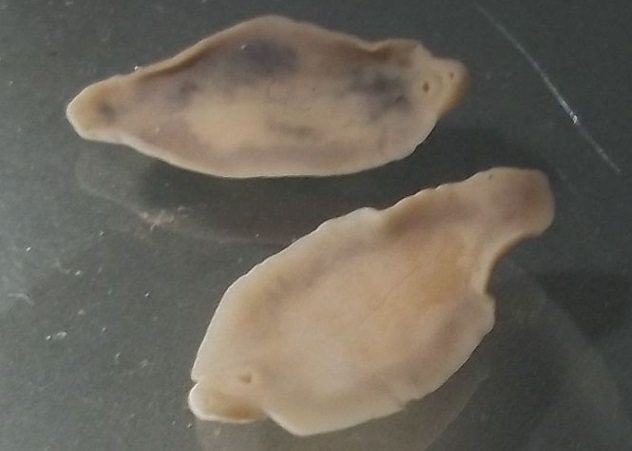
Liver flukes are parasites that infect the bile ducts and liver. They are one of a number of flatworms that breed in freshwater snails. One way they can infect humans is through the consumption of freshwater fish that share the same environment.
These flat-looking parasites can cause few symptoms in humans. Therefore, someone can be infected without ever knowing it. Mature flukes will eventually cause chronic inflammation of the bile ducts, which often leads to gallstones.[2] While the majority of cases are found in developing countries, there have been cases in Hawaii, California, and Florida.
8 Hookworms
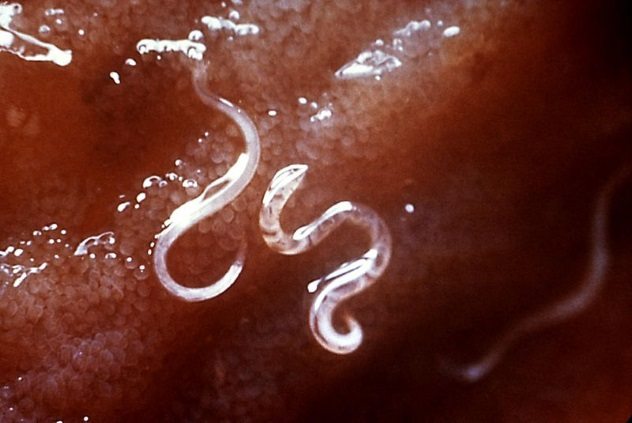
Two kinds of hookworms that can infect human hosts are Ancylostoma duodenale and Necator americanus. Hookworms make an interesting journey through the human body. They enter through the feet and can sometimes leave itchy rashes at their entry point. They will travel along the bloodstream until they can enter the lungs. Once in the lungs, they irritate lung tissue enough that the infected host coughs them up into their mouth. If even a little bit of that bloody, wormy phlegm gets swallowed, the hookworm is happily in its desired home: the small intestine.
This is a parasite that has been particularly prominent in some communities because it can be transferred from person to person through poop. If infected stool isn’t managed properly or is spread in soil, it can infect others easily. Therefore, now that we have better sanitation practices, hookworm infection has diminished, but it hasn’t disappeared.
It has been argued that the American South was left in an economic lethargy because of hookworms. For about 300 years, nearly 40 percent of the population was infected.[3] If someone is heavily infected with hookworms, it can cause lethargy and mental incapacity. Therefore, with so much of the population infected, the South didn’t have the ability to keep up with its wormless neighbors. Otherwise, there are very few symptoms.
7 Pinworms
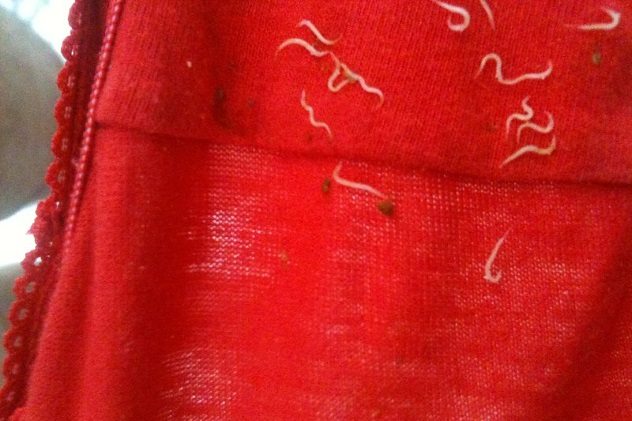
Pinworms are a parasite that can spread very easily. They are generally the most common parasitic infection in North America. They live on the human anus, so it takes just one scratch, and then anything that person touches can be covered with pinworm eggs. If someone swallows an egg, they become infected.[4]
There are generally very few symptoms; sometimes it’s just a mild irritation, which encourages the infected host to scratch their butt and keep spreading the eggs. Mostly, pinworm infections are found in children, but they can easily infect anyone who has been exposed to them.
6 Ascariasis

Ascariasis is a roundworm infestation that attacks the small intestine. It usually spreads from exposure to human feces or uncooked meat, however it can also spread via human-to-human contact.[5] Usually, it has few symptoms, unless the host has a large infestation of these roundworms.
Children are the most likely to display symptoms, and they’re often at a higher risk of getting infected with ascariasis because of their tendency to put their hands in their mouths. They can suffer bloated stomachs and pain as a result. Mostly though, the little roundworms just live in your stomach until they are ready to be pooped out.
5 Echinococcus Granulosus

Our canine besties can give us a parasite that will slowly grow inside humans for years without symptoms.
Echinococcus granulosus mainly infects dogs but can also get inside humans who have been exposed to canine feces or have even just petted a dog. It is a tapeworm-like larva that will create cyst-like lesions in the liver or lungs.[6]
4 Trichinosis

Trichinosis is a roundworm infestation that usually occurs after eating undercooked or raw meat. It is mostly found in boar or pig meat. So if you’ve been hankering on having a medieval feast with your chums, make sure to cook that boar all the way through.
Once the trichinosis larva is in the intestines, it will develop into a mature worm, which will produce more larvae that can go through muscles and other body tissues.[7] If a small sample of larvae is swallowed, the infected host might never know that they have trichinosis. However, a large infestation causes intestinal pain and diarrhea.
3 Dientamoeba Fragilis
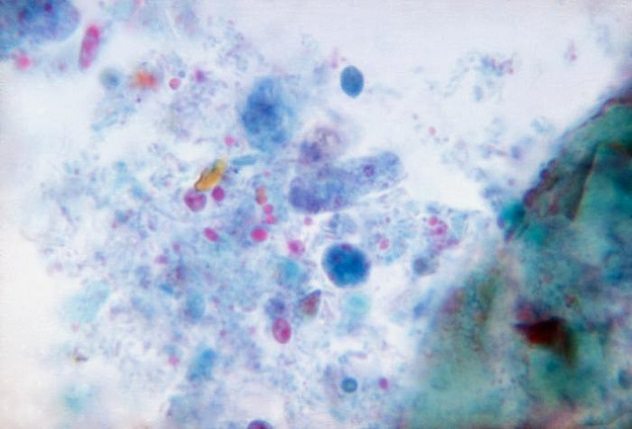
This single-celled parasite is fairly mysterious. Not only do scientists and medical professionals not know how it is transmitted, but they don’t know if it produces any symptoms in human hosts.[8] It might cause diarrhea and abdominal pain in some cases, but mostly, it is asymptomatic.
There have been some connections with pinworms, and it is conjectured that transmission comes from eating the eggs, but really we don’t know much about this pervasive parasite. We do know that Dientamoeba fragilis can infect large populations without anyone knowing they have a parasite in them.
2 Microsporidia

This group of single-celled parasitic fungi can infect a huge range of creatures, and humans are among them.[9] Unless the human host is weakened in some manner (such as being immunocompromised), the fungi can exist asymptomatically and harmlessly. These spore-forming parasites often live in fish.
Microsporidia were originally considered to be protists. However, their genomes resembled fungi more than other eukaryotic organisms, and they are now classified as such.
1 Toxoplasma Gondii
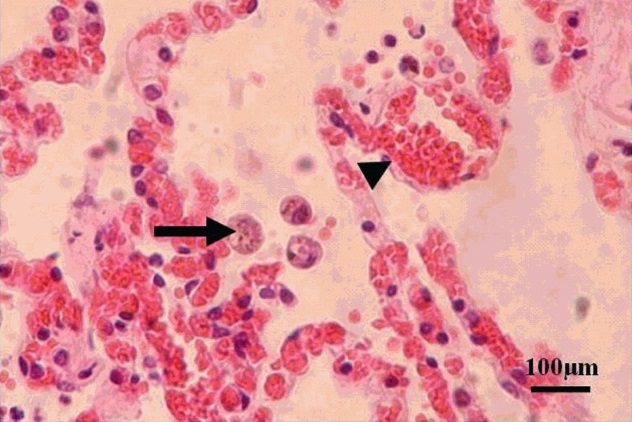
This parasite might be one of the most famous, partly because it can be found in nearly a third of the world’s population and partly because it might alter someone’s brain, which sounds like something out of a science fiction novel. Toxoplasma gondii is a parasite aims to be in the gut of a cat. How it gets there is fascinating. It will infect rats and mice that have been exposed to cat feces. Then it will travel to the brain and pretty much take over the rodent’s natural fear of predators, turning it into attraction. The rodents, instead of running away like they normally would do, instead seek out cats and promptly get eaten. The parasite has then succeeded in its goal of ending up in a cat’s gut.
Where it gets weird is that Toxoplasma gondii can also infect humans. There are generally no symptoms unless the person infected is pregnant. However, the parasites might also try to change the brain chemistry of their human hosts, potentially leading to schizophrenia and suicide.[10] At least one scientist attributes Toxoplasma gondii with political dissent and higher rates of car crashes. This, however, hasn’t been accepted by mainstream scientists. But maybe next time you forget to pay your bills or walk into traffic, you can blame your cat’s parasites.
Hannah Storrs is a freelance writer who has written primarily for hiking websites like The Trek. She is based out of Montreal, QC. If you like her work, you can find more at https://www.hannahstorrs.com/
READ MORE BLURB GOES HERE Top 10 Most Horrific Parasite Infections and Top 10 Most Disgusting Parasites.








